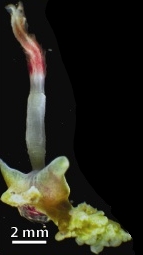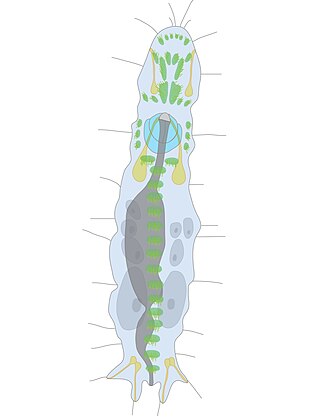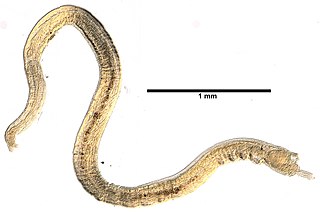Nonnus of Panopolis was the most notable Greek epic poet of the Imperial Roman era. He was a native of Panopolis (Akhmim) in the Egyptian Thebaid and probably lived in the 5th century CE. He is known as the composer of the Dionysiaca, an epic tale of the god Dionysus, and of the Metabole, a paraphrase of the Gospel of John. The epic Dionysiaca describes the life of Dionysus, his expedition to India, and his triumphant return. It was written in Homeric Greek and in dactylic hexameter, and it consists of 48 books at 20,426 lines.

Kinorhyncha is a phylum of small marine invertebrates that are widespread in mud or sand at all depths as part of the meiobenthos. They are also called mud dragons. Modern species are 1 mm (0.039 in) or less, but Cambrian forms could reach 4 cm (1.6 in).

Osedax is a genus of deep-sea siboglinid polychaetes, commonly called boneworms, zombie worms, or bone-eating worms. Osedax is Latin for "bone-eater". The name alludes to how the worms bore into the bones of whale carcasses to reach enclosed lipids, on which they rely for sustenance. They utilize specialized root tissues for bone-boring. It is possible that multiple species of Osedax reside in the same bone. Osedax worms are also known to feed on the collagen itself by making holes in the whale's skeletal structure. These holes can also serve as a form of protection from nearby predators.

Acoelomorpha is a subphylum of very simple and small soft-bodied animals with planula-like features which live in marine or brackish waters. They usually live between grains of sediment, swimming as plankton, or crawling on other organisms, such as algae and corals. With the exception of two acoel freshwater species, all known acoelomorphs are marine.

The Piccola Accademia di Montisi is a music academy for harpsichord students and recent graduates located in Montisi, a hill town in the Province of Siena, in Southern Tuscany. It provides masterclasses with students playing on its collection of restored historic instruments and modern copies. It also holds an annual summer festival with concerts of harpsichord music and other works from the Baroque period which feature the instrument. The academy was founded in 2006 by harpsichord-maker and collector Bruce Kennedy who had been making harpsichords based on 18th-century models since the 1980s. He remains the academy's executive director.

Polynoidae is a family of marine Polychaete worms known as "scale worms" due to the scale-like elytra on the dorsal surface. Almost 900 species are currently recognised belonging to 9 subfamilies and 167 genera. They are active hunters, but generally dwell in protected environments such as under stones. The group is widely distributed from shallow intertidal waters to hadal trenches. They are the most diverse group of polychaetes in terms of genus number and second most diverse in terms of species number which is almost 8% of all segmented worm species.

Ambulacraria, or Coelomopora, is a clade of invertebrate phyla that includes echinoderms and hemichordates; a member of this group is called an ambulacrarian. Phylogenetic analysis suggests the echinoderms and hemichordates separated around 533 million years ago. The Ambulacraria are part of the deuterostomes, a clade that also includes the many Chordata, and the few extinct species belonging to the Vetulicolia.
The Diocese of Nocera dei Pagani-Sarno, commonly known as Diocese of Nocera Inferiore-Sarno, is a Latin Church diocese of the Catholic Church located in the Campania region of Italy. It is a suffragan of the Archdiocese of Salerno-Campagna-Acerno.

Protostomia is the clade of animals once thought to be characterized by the formation of the organism's mouth before its anus during embryonic development. This nature has since been discovered to be extremely variable among Protostomia's members, although the reverse is typically true of its sister clade, Deuterostomia. Well known examples of protostomes are arthropods, molluscs, annelids, flatworms and nematodes. They are also called schizocoelomates since schizocoely typically occurs in them.

Hermann Baagøe Storck was a Danish architect and heraldist. As an architect, he is mainly known for the restoration of historic buildings. Among his own designs, his building for the Hirschsprung Collection in Copenhagen is the most widely known.

Sal N. DiDomenico is an American state legislator who has served in the Massachusetts Senate since May 2010 and as Assistant Majority Leader since 2018. He is a Democrat representing the Middlesex and Suffolk district, which includes his hometown of Everett as well as Chelsea, Allston, Brighton, Charlestown, and parts of Cambridge and Boston. In 2010, he won a special election to succeed the retiring Anthony D. Galluccio. Before that, he spent three years as Gallucio's chief of staff. From 2004 to 2010 he was a member of the Everett City Council.

Errantia is a diverse group of marine polychaete worms in the phylum Annelida. Traditionally a subclass of the paraphyletic class Polychaeta, it is currently regarded as a monophyletic group within the larger Pleistoannelida, composed of Errantia and Sedentaria. These worms are found worldwide in marine environments and brackish water.

Diurodrilus is a genus of tiny marine animals that has traditionally been assigned to the annelid worms, although this affinity is not certain. With a maximum length of 0.45 mm, it has an unusual morphology with many traits not found in other annelids, including a ventral creeping foot. Analyses of DNA have both refuted and supported placement within the annelids, with the unusual morphology perhaps due to evolutionary progenesis, in which organisms develop sexual maturity while retaining the larval traits of their ancestors.

Osedax roseus is a species of bathypelagic polychaete worm that lives at abyssal depths and is able to sustain itself on the bones of dead whales. The species is found in the North East Pacific.
Aberranta is a genus of polychaete thought to be related to the Nerillidae.

Flabelligeridae is a family of polychaete worms, known as bristle-cage worms, notable for their cephalic cage: long slender chaetae forming a fan-like arrangement surrounding the eversible head. Unlike many polychaetes, they also have large, pigmented, complex eyes.

Protodrilida is an order of polychaetes belonging to the class Polychaeta.

Sedentaria is a diverse clade of annelid worms. It is traditionally treated as a subclass of the paraphyletic class Polychaeta, but it is also a monophyletic group uniting several polychaetes and the monophyletic class Clitellata. It is the sister group of Errantia.














